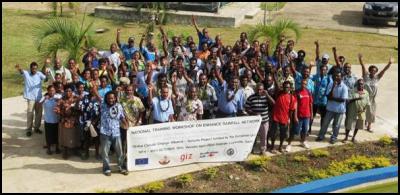Strengthening forecasting systems in the Pacific
25 February 2014
Strengthening forecasting systems in the Pacific

Image: Roan Plotz in Vanuatu working with the Met department and Rainfall Network for training in traditional knowledge data collection.
Ancient wisdom can be put to practical use when combined with modern weather forecasting tools, according to Victoria University of Wellington PhD candidate Roan Plotz.
Roan, a traditional ecological knowledge scientist for the Climate and Ocean Support Program in the Pacific (COSPPac), is working with Pacific meteorological services on collating traditional weather and climate knowledge, verifying the information and using it to make seasonal forecasts more useful to Pacific Island communities.
The first step, says Roan, is to identify what local people use to predict what weather is coming and then monitor those traditional indicators to see if they correlate to actual weather patterns.
“In parts of the Pacific, for example, people believe there is a strong correlation with the amount of fruiting and how much rainfall will fall in the next season. This has been shown to be true,” says Roan.
The ultimate goal of the study, funded by the Australian Department of Foreign Affairs and Trade, is to bridge the gap between traditional indicators and scientific techniques to improve weather and climate forecasting abilities.
“The Pacific Islands are vulnerable to sea level rise and severe weather events and have always kept a close eye on the seasons,” says Roan.
“Many communities favour traditional ways—such as reading signs of nature, animals and plants—over scientific ways, partly due to lack of exposure to modern forecasting tools.”
After assessing traditional indicators, it is hoped that the Pacific Met Services will be better placed to inform their local communities about what should be monitored in order to help them better adapt to an increasingly variable climate.
“It’s much more relevant if we can tell people for a fact that monitoring a certain tree, or plant, or animal allows you to forecast as accurately as modern forecasting tools.”
Roan’s experience with indigenous knowledge had its origins in his PhD study of the tick bird and black rhinoceros relationship. With the support of the Centre of Biodiversity and Restoration Ecology at Victoria University, Roan explored the validity of the African tick bird’s indigenous name ‘The Rhino’s Guard’.
“Unknown at the time, my PhD research led to my current role in the Pacific. My training in ecological science at Victoria and field experiences in Africa gave me the foundation I needed.”
Roan submitted his PhD thesis last year and now works for the COSPPac program at the Australian Bureau of Meteorology in Melbourne.
ENDS


 Science Media Centre: Carbon-storing Construction Materials – Expert Reaction
Science Media Centre: Carbon-storing Construction Materials – Expert Reaction Vegetables New Zealand: New Web-Based Tool Will Help Greenhouse Growers Switch To Geothermal Heating
Vegetables New Zealand: New Web-Based Tool Will Help Greenhouse Growers Switch To Geothermal Heating Horizon Research Limited: New Poll - New Zealanders Prefer Rail Enabled Ferries
Horizon Research Limited: New Poll - New Zealanders Prefer Rail Enabled Ferries Watercare: Watercare Gets To Work On First Permanent Non-Potable Water Tanker Filling Station In Māngere
Watercare: Watercare Gets To Work On First Permanent Non-Potable Water Tanker Filling Station In Māngere Alcohol Healthwatch: Licensing Decision Lauded For Prohibiting Buy Now Pay Later Schemes In Bottle Stores
Alcohol Healthwatch: Licensing Decision Lauded For Prohibiting Buy Now Pay Later Schemes In Bottle Stores Motor Industry Association: Vehicle Registrations Up 5.6% In December, But Year-To-Date Sales Reflect Market Challenges
Motor Industry Association: Vehicle Registrations Up 5.6% In December, But Year-To-Date Sales Reflect Market Challenges



